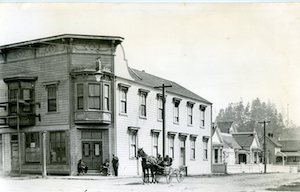
March 8, 1916 – A number of young boys were taken before Judge William True Wallace at the Big River Justice Court. The lads were accused of tampering with the switches that controlled the street lights, turning them on and off at will.
In addition, the local electric company had suffered considerable annoyance and financial loss by boys shooting and breaking the street lamps’ glass. The Beacon explained that not only was this mischievous and annoying to the company, but a live wire could drop to the ground and kill or seriously injure someone. The judge gave the boys “a good talking-to.”
“Boys will be boys, but they should not go too far. Judge Wallace stated that if these tricks are kept up, he would severely punish any offenders, who may be brought before him.’’
Photo: Photograph of J. D. Johnson’s building on the northeast corner of Lansing and Ukiah Streets, sometimes referred to as the Justice Court Building, 1902-1915. A sign on the door to the left reads, “Justice Court.” The building at this time had many architectural embellishments: window pediments and brackets, cresting above the corner bay window, and an ornate false front across the Lansing Street elevation.
Rough board scaffolding is attached to the west side of the building, and penciled on the photo is a notation that reads, “Scaffolding up for 17 years.” A Mendocino Beacon article (3 Jul 1915, p. 5) establishes the upper date range of this photo: “J. D. Johnson removed the scaffolding from his building on the corner of Ukiah and Lansing Streets this week. The scaffolding has been in place for about seventeen years and its removal makes a great improvement in the appearance of that part of town.”
Three men are sitting on the steps in front of the building’s corner door. Two passengers travel in a horse and buggy on Ukiah Street. A street light is suspended by wires above the intersection. Since Mendocino didn’t have electricity until 1902, the image must have been taken after that year.
Two one-story cottages, with numerous brackets and decorative details, sit behind the corner Johnson Building. They were also built by Johnson, who kept them as rentals.
Farther down the street, at the northeast corner of Howard and Ukiah, the west elevation and the front of the Bowman House is visible. Johnson built this house in 1879 for George Bowman and his family. When Mr. Bowman died in 1911, Johnson purchased it, made some improvements, and in 1918 James Bowman, son of George Bowman, moved his own family into his boyhood home, as a tenant.
This view down Ukiah Street at these similarly ornate buildings clearly demonstrates J. D. Johnson’s architectural style.
More historical photos of Mendocino available in “Perley Maxwell’s Mendocino,” by Bruce Levene. Includes the Mendocino High School Photography Students 2002 Then & Now Project. $25.